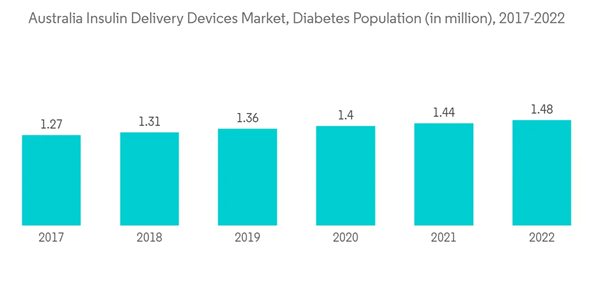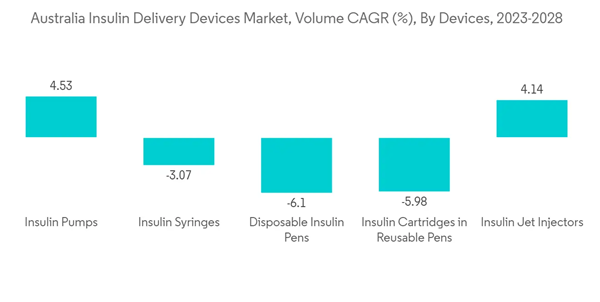The Australia Insulin Delivery Devices Market size is estimated at USD 705.52 million in 2024, and is expected to reach USD 794.35 million by 2029, growing at a CAGR of 2.40% during the forecast period (2024-2029).
During the COVID-19 pandemic, patients with diabetes were at higher risk for hospitalizations and complications due to hyper- or hypoglycemia, metabolic comorbidities, and more severe illness from SARS-CoV-2 infection. Throughout the COVID-19 pandemic, the effects of diabetes worsened with infection and infection-induced new-onset diabetes in both adults and children. Diabetes self-management, follow-up care, and glycemic management were disrupted during the COVID-19 pandemic, which recognized the need for proper guidelines and protocols to ensure successful continuity of management and follow-up care for people with existing and new-onset diabetes.
Diabetes is a chronic condition characterized by high blood glucose levels caused by the inability to produce insulin or use insulin effectively, or both. The main types of diabetes are type 1 diabetes and type 2 diabetes. For a patient with type 1 diabetes, insulin therapy is important for replacing the insulin the body doesn't produce. People with type 2 diabetes or gestational diabetes need insulin therapy if other treatments, such as diabetes medications and other lifestyle changes, cannot keep blood glucose levels within the desired range. Diabetes treatment aims to maintain healthy blood glucose levels to prevent short- and long-term complications, such as cardiovascular disease, kidney disease, blindness, and lower limb amputation.
Diabetes has a significant and often preventable impact on the health and well-being of the Australian population. The Australian Government reviews processes and infrastructure to ensure adequate supplies and supply chains of essential medications, glucose monitoring equipment, insulin pump consumables, and measures to manage diabetes. People with diabetes who have disabilities require specialized assistance managing their diabetes, including accessing health services, administering insulin, and operating diabetes devices.
The overall CAGR is impacted by consumers switching from insulin pens and syringes to insulin pumps due to increased efficacy and patient compliance.
Currently, almost 1.9 million Australians have diabetes, including all types of diagnosed diabetes (almost 1.5 million known and registered) and undiagnosed type 2 diabetes (up to 500,000 estimated). The incidence of diabetes in children and young people is increasing. Almost all children and young people with diabetes have type 1 diabetes. In addition, children develop type 2 diabetes at younger ages. Children and young people with type 1 and type 2 diabetes have specific needs, such as access to care from a multidisciplinary pediatric diabetes team and to diabetes treatments and supporting technologies.
Around 1.2 million people are hospitalized with diabetes-related conditions every year. Aboriginal and Torres Strait Islander Australians are three times more likely to develop type 2 diabetes than non-Indigenous Australians, 4.3 times more likely to be hospitalized with type 2 diabetes, and four times as likely to die. Various evidence suggests that diabetes can be successfully managed, especially when detected early. Multifactorial intervention, including control of blood glucose, blood pressure, and lipids, can reduce the range of diabetes-related microvascular and macrovascular complications and premature mortality.
Australian Commission on Safety and Quality in Health Care clinical care standards program plays an important role in delivering appropriate care and reducing unwarranted variation, as they identify and define the care people should be offered or receive, regardless of where they are treated. The National Association of Diabetes Centre has developed diabetes care standards and an accreditation process that can help to make diabetes care nationally consistent.
Therefore, the studied market is anticipated to grow over the analysis period due to rising prevalence and the factors above.
An insulin pump is a small battery-operated electronic device about the size of a pager or small mobile phone. The rapid-acting insulin is delivered via an infusion set inserted under the skin, i.e., subcutaneously. The device delivers insulin in two ways, basal (delivering small amounts of insulin continuously to maintain cell function) and bolus (delivering a dose of insulin on demand to account for the carbohydrates in meals or to correct high blood glucose levels). An insulin pump is worn 24 hours a day but can be taken off for up to two hours when required.
Data can be uploaded from insulin pumps via web-based software. The data relating to glucose concentrations and insulin delivery can be reviewed by the health professional with the patient. Randomized controlled trials have reported improved glycemic control using insulin pump therapy compared to multiple daily injections. These include reductions in blood glucose, hypoglycemia, lower glycated hemoglobin, lower insulin requirements, and improved quality of life. Type-1 diabetic patients must check their blood glucose levels regularly, monitor their blood glucose levels, and adjust the insulin dosing to maintain optimum glucose levels.
The Australian Government is maintaining access to affordable, high-quality medicines, devices, and services to support people with diabetes in self-management and treatment. It supports people with diabetes through the National Diabetes Services Scheme, the Pharmaceutical Benefits Scheme, the Insulin Pump Program, and Medicare and other funding. Insulin pump consumables (infusion sets and reservoirs/cartridges) are subsidized by the NDSS for eligible consumers only. Under the NDSS, the cost of an infusion set is currently about $1.60. The cost of an insulin reservoir/cartridge is about $1 per unit.
The factors above are likely to drive segment growth during the forecast period.
This product will be delivered within 2 business days.
During the COVID-19 pandemic, patients with diabetes were at higher risk for hospitalizations and complications due to hyper- or hypoglycemia, metabolic comorbidities, and more severe illness from SARS-CoV-2 infection. Throughout the COVID-19 pandemic, the effects of diabetes worsened with infection and infection-induced new-onset diabetes in both adults and children. Diabetes self-management, follow-up care, and glycemic management were disrupted during the COVID-19 pandemic, which recognized the need for proper guidelines and protocols to ensure successful continuity of management and follow-up care for people with existing and new-onset diabetes.
Diabetes is a chronic condition characterized by high blood glucose levels caused by the inability to produce insulin or use insulin effectively, or both. The main types of diabetes are type 1 diabetes and type 2 diabetes. For a patient with type 1 diabetes, insulin therapy is important for replacing the insulin the body doesn't produce. People with type 2 diabetes or gestational diabetes need insulin therapy if other treatments, such as diabetes medications and other lifestyle changes, cannot keep blood glucose levels within the desired range. Diabetes treatment aims to maintain healthy blood glucose levels to prevent short- and long-term complications, such as cardiovascular disease, kidney disease, blindness, and lower limb amputation.
Diabetes has a significant and often preventable impact on the health and well-being of the Australian population. The Australian Government reviews processes and infrastructure to ensure adequate supplies and supply chains of essential medications, glucose monitoring equipment, insulin pump consumables, and measures to manage diabetes. People with diabetes who have disabilities require specialized assistance managing their diabetes, including accessing health services, administering insulin, and operating diabetes devices.
The overall CAGR is impacted by consumers switching from insulin pens and syringes to insulin pumps due to increased efficacy and patient compliance.
Australia Insulin Delivery Devices Market Trends
Rising Diabetes Prevalence in Australia
According to Diabetes Australia, diabetes is the fastest-growing chronic condition in Australia, increasing faster than other chronic diseases such as heart disease and cancer.Currently, almost 1.9 million Australians have diabetes, including all types of diagnosed diabetes (almost 1.5 million known and registered) and undiagnosed type 2 diabetes (up to 500,000 estimated). The incidence of diabetes in children and young people is increasing. Almost all children and young people with diabetes have type 1 diabetes. In addition, children develop type 2 diabetes at younger ages. Children and young people with type 1 and type 2 diabetes have specific needs, such as access to care from a multidisciplinary pediatric diabetes team and to diabetes treatments and supporting technologies.
Around 1.2 million people are hospitalized with diabetes-related conditions every year. Aboriginal and Torres Strait Islander Australians are three times more likely to develop type 2 diabetes than non-Indigenous Australians, 4.3 times more likely to be hospitalized with type 2 diabetes, and four times as likely to die. Various evidence suggests that diabetes can be successfully managed, especially when detected early. Multifactorial intervention, including control of blood glucose, blood pressure, and lipids, can reduce the range of diabetes-related microvascular and macrovascular complications and premature mortality.
Australian Commission on Safety and Quality in Health Care clinical care standards program plays an important role in delivering appropriate care and reducing unwarranted variation, as they identify and define the care people should be offered or receive, regardless of where they are treated. The National Association of Diabetes Centre has developed diabetes care standards and an accreditation process that can help to make diabetes care nationally consistent.
Therefore, the studied market is anticipated to grow over the analysis period due to rising prevalence and the factors above.
The Insulin Pumps Segment is Expected to Witness the Highest Growth Rate Over the Forecast Period
Insulin Pump is expected to register a CAGR of more than 4.5% in the market during the forecast period because of the increasing technological advancement and its preference over other traditional methods due to continuous insulin administration.An insulin pump is a small battery-operated electronic device about the size of a pager or small mobile phone. The rapid-acting insulin is delivered via an infusion set inserted under the skin, i.e., subcutaneously. The device delivers insulin in two ways, basal (delivering small amounts of insulin continuously to maintain cell function) and bolus (delivering a dose of insulin on demand to account for the carbohydrates in meals or to correct high blood glucose levels). An insulin pump is worn 24 hours a day but can be taken off for up to two hours when required.
Data can be uploaded from insulin pumps via web-based software. The data relating to glucose concentrations and insulin delivery can be reviewed by the health professional with the patient. Randomized controlled trials have reported improved glycemic control using insulin pump therapy compared to multiple daily injections. These include reductions in blood glucose, hypoglycemia, lower glycated hemoglobin, lower insulin requirements, and improved quality of life. Type-1 diabetic patients must check their blood glucose levels regularly, monitor their blood glucose levels, and adjust the insulin dosing to maintain optimum glucose levels.
The Australian Government is maintaining access to affordable, high-quality medicines, devices, and services to support people with diabetes in self-management and treatment. It supports people with diabetes through the National Diabetes Services Scheme, the Pharmaceutical Benefits Scheme, the Insulin Pump Program, and Medicare and other funding. Insulin pump consumables (infusion sets and reservoirs/cartridges) are subsidized by the NDSS for eligible consumers only. Under the NDSS, the cost of an infusion set is currently about $1.60. The cost of an insulin reservoir/cartridge is about $1 per unit.
The factors above are likely to drive segment growth during the forecast period.
Australia Insulin Delivery Devices Industry Overview
The Australia Insulin Delivery Devices Market is consolidated, with few significant players. The major players such as Insulet Corporation, Ypsomed, and Novo Nordisk are working on innovations in insulin devices which is evident from the companies spending on research and developments to strengthen their market presence further.Additional Benefits:
- The market estimate (ME) sheet in Excel format
- 3 months of analyst support
This product will be delivered within 2 business days.
Table of Contents
1 INTRODUCTION
4 MARKET DYNAMICS
5 MARKET SEGMENTATION
6 MARKET INDICATORS
7 COMPETITIVE LANDSCAPE
Companies Mentioned (Partial List)
A selection of companies mentioned in this report includes, but is not limited to:
- Novo Nordisk
- Sanofi
- Eli Lilly
- Biocon
- Julphar
- Medtronic
- Ypsomed
- Becton Dickinson
- Insulet Corporation
Methodology

LOADING...










